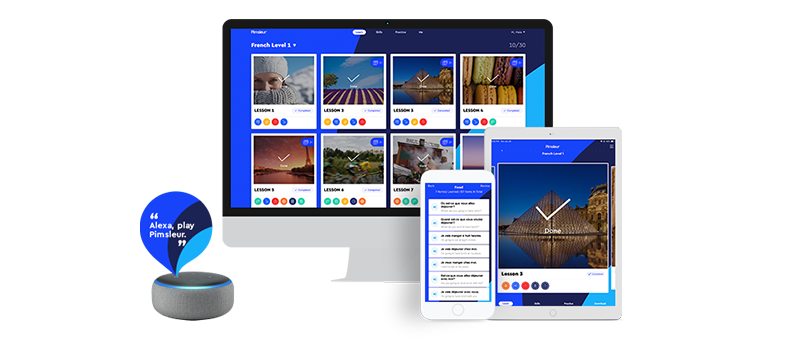
Want to Learn Faster? Design an At Home Language Immersion Program
How to Create an At Home Language Learning Study Plan
I am a language teacher. One of the most common complaints I hear from language students is that they can’t seem to make progress. They feel stuck.
But when I ask them how they are studying, they tell me they are using a free language app for ten minutes a day. No wonder they are not making any progress!
If you want to get fluent in—or even just good at—a language, you’re going to need a comprehensive language study program. Pimsleur’s language lessons are great for this, but you may still want to complement those lessons with outside material.
Luckily, language programs aren’t difficult to make on your own. In this article, you’ll get a step-by-step breakdown of how to create an at-home language immersion program for yourself. This is the same program I encourage my students to make to complement their lessons.
Use this program to keep yourself motivated and on track to learn your target language.

4 Principles for Your At Home Language Immersion Program
The actual process of learning a language isn’t complicated, but there are a few things you should keep in mind.
1. Practice Daily
You’ll acquire a language fastest when you are exposed to it daily. You don’t have to study for hours each day—in fact, it’s better if you don’t. Ideally, you would spend between half an hour and an hour and a half practicing each day.
2. Be an Active Participant
Learning is most effective when you are processing and using your language. Sure, listen to a podcast when you’re at the gym or while you’re making dinner, but also try to spend some time sitting down and focusing on your language activities.
3. Find the right level.
You don’t want to choose activities that are too hard, but you don’t want ones that are too easy, either. Find activities that are a bit challenging, but that are not overwhelming. Pimsleur’s graded levels make this easy, but you can do it yourself, too. Just make sure that you gradually make your activities more difficult as you improve.
4. Use All Four Skills.
You need four skills to use a language: listening, speaking, reading, and writing. Your home language study program should include activities for each of these skills.

5 Steps to Create a Language Study and Immersion Program at Home
Step 1: Take an exam to test your level.
Before you start designing your language study program, reflect on what your current level is. That way, you will be able to know how challenging your activities should be. It will also help motivate you: Seeing your progress will encourage you to keep at it in the long-run.
To find out your level, use your favorite search engine to look for a free online test.
Step 2: Set a language goal.
The next step is figuring out where you want to go. Choose a specific goal that matters to you and that you can easily tell when you have accomplished it. For example, your goal could be to:
- Be able to order a beer at a bar in Portuguese
- Be able to have a conversation about politics in Japanese
- Be able to understand a Spanish TV series on Netflix
- Be able to read the news in French
- Get to a C1 level in Italian on the CEFR.
Setting yourself a goal is helpful. Not only will it guide the activities that you choose, but it will also help you stay motivated to stick to your language program and do a little bit every day.
Step 3: Choose your activities.
Now you want to choose the activities.
The trick is to choose activities that you enjoy. The reason is that if you find language learning a chore, you won’t do it. And you shouldn’t find it a chore; learning a language should be fun!
By choosing activities that you like, you’ll look forward to doing them, and you’ll end up learning faster. Here are some examples of activities you can do for each of the four skills.
Speaking
- Make online friends. The best way to get good at speaking another language is by actually speaking it. And the Internet makes it easy to have virtual conversations with native speakers of your target language. We have a list of places you can find native speakers here, and tips for successful online language exchange here.
- Join a conversation club. Most cities have conversation clubs. Check out MeetUp for conversation groups in your city. Or, look at your local library or community center. If you can’t find one that’s already established for your language, start your own!
Listening
- Podcasts. Podcasts are an amazing way to learn a language. They help you with both your listening skills and your speaking skills. You can find podcasts in other languages on Spotify and Apple podcasts as well as many other applications. TuneIn is another great option for finding podcasts in your target language.
- Netflix. Netflix can be a great way to learn a language while you’d otherwise just be watching TV. Just make sure you don’t rely on English subtitles. If you do, you won’t learn as much. Instead, try watching without subtitles, or with subtitles in your target language. You might understand less at first, but you’ll learn faster.
- YouTube. YouTube is filled with interesting, useful content. If you already spend time on YouTube, maximize that time by watching videos in your target language. For example, here’s a list of great channels to follow to practice Spanish.
Reading
- Read. If you’re at a lower level, find simple, short articles that you can understand. As your language progresses, look for more challenging articles or read the news. You can even re-read a favorite book, like Harry Potter or an Agatha Christie, in your target language. Just make sure you’re enjoying what you’re reading.
- Social media. Social media is a great place to practice your reading—and you’re probably on it already. Look for engaging people to follow and then take some time every day to scroll through their content. For example, you can keep up with Brazilian slang on Instagram, follow famous French chefs, or see what Spanish pop stars are up to.
- Read recipes. What better way to explore a culture than through its food? Recipes can be a great way to learn vocabulary for food, kitchen objects, and cooking verbs. And the best part is that, in the end, you’ll have a delicious meal. Try a traditional French onion soup, an Italian pizza, a Brazilian feijoada, Chinese noodles, or Japanese ramen.
Writing
- Write letters. Writing letters is a bit of a lost art… so why not pick it up in your target language? You’ll build a relationship and have some fun while you do it. And, if the paper and pen method gets too challenging to keep up with, you can always move to email. Here are some tips for writing a love letter in Italian.
- Send text messages. Text messaging is a great way to practice your writing. Find a friend who’s interested in practicing with you and make a text message part of your daily ritual. Don’t have any friends you can text in your target language? Try leaving comments on Facebook, Instagram, or Twitter instead.
- Online dating. Are you single? Consider changing your dating app settings to a country that speaks your target language. I have a Brazilian friend who did this, and now she texts daily with a Norwegian guy. They’re both practicing English. It might not be a good strategy to actually find a partner, but it’s a great way to practice your writing skills. Before you jump in, take a quick look at our guide to dating differences between Americans and Europeans.
Step 4: Make a schedule.
Now that you have your activities, set aside some time to do them.
Try to make time for an activity every day. For example, maybe you use Pimsleur’s language learning platform Monday thru Friday for a half-hour before work, listen to a podcast while you’re working out on Tuesdays and Thursdays, read a foreign language news article on Wednesdays, and chat with a friend on Saturday mornings. Daily practice will help you make real progress.
Consider also that you can often replace your language learning with other activities you would normally do. For example, instead of watching Netflix or browsing social media in English, watch or browse in Spanish. Instead of looking up recipes for dinner in English, look at them in Italian. Rather than texting with your friends in English, text in Portuguese. These are all ways of building learning activities into your day without spending any extra time to study.
Step 5: Re-evaluate and revise.
Finally, re-evaluate your program regularly. If you’re following it and you find you’re progressing quickly, choose new activities that continue to be challenging for you at your higher level.
Or, if you find that it’s not working, revise the program. Maybe you aren’t truly enjoying your activities so you aren’t doing them. Or maybe they’re not at the right level.
Readjust so that your home language study program works for you.
Last Thoughts
It will be difficult to progress in your language if you don’t give yourself a structure to follow.
Pimsleur makes it easy because all the steps and skills are included in the language program.
But even if you’re using a language program, you can complement it with other activities. Remember that the more you engage with the language, the faster you will learn it.
What is the most essential part of a home language study program? Sticking with it! If you engage with your target language daily over a long period of time, you’ll eventually learn it. Learning a language is a lot of work, but it can be fun and very rewarding. It’s worth it!

Download the Pimsleur app now and try a free week! Or test-drive a free lesson! Start listening, speaking, and testing your skills and have fun! Choose from over 50+ languages.
3 Comments for "Want to Learn Faster? Design an At Home Language Immersion Program"